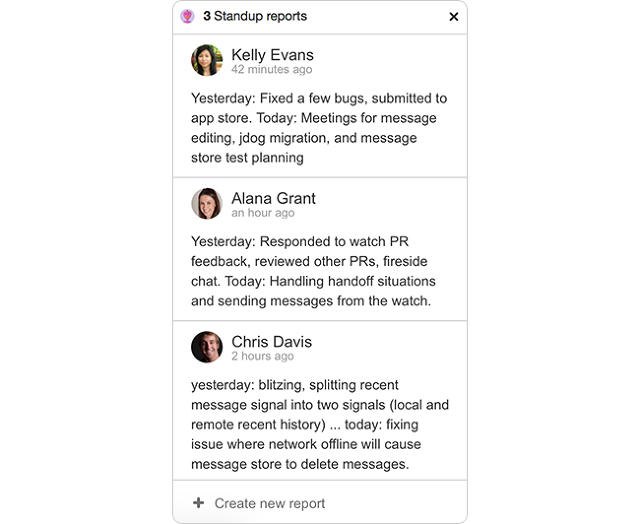Bot Or Not: How HipChat Uses Automation For Team Productivity
The HipChat team gets a lot of value out of bots because we know when to use them and when apps are a better choice. To be fair, not every team spends their days obsessing over the ins and outs for group messaging platforms like we do, so sometimes it isn’t always clear what to automate—or even what the options are.
But you don’t have to be an engineer to squeeze the most productivity out of your team on whichever collaborative platform your company uses. It’s all about deciding what type of task you need to complete. Here’s how we make that call, then look for the right means of automating it—or not.
To Bot Or Not To Bot?
First, some semantics: Almost every service bot you encounter in a chat service—whether it’s to order an Uber within a room, receive notifications from PagerDuty, or track customer activities on Salesforce—is what’s known as a “full” service outside of the chat platform itself. In these situations, the bot’s job is to relay a user’s text back to a service instead of through the service interface itself.
This can be helpful in cases of a simple question-and-answer interaction:
- “What’s the weather?”
- “Is the site performing?”
- “Did someone respond to that customer?”
Each of these queries is simple enough for a bot to handle without any additional interaction from the user. Here at HipChat, this is where we see the most opportunity for developers: The demand for this type of bot continues to grow.
However, if the problem is more complex and requires more detail to solve, applications are a much better option. Uber isn’t a workplace tool, but it’s a good example of this distinction, because ordering a ride is a complex request that requires a lot of information, and delivering it is a service that Uber has already spent years refining. So while I can order an Uber using a bot inside HipChat, it’s probably better to open the Uber app on my phone, where I’ll immediately see a map with my location, the real-time position of the driver, the route of my trip, and a fare estimate all at once. With one click of a button on that interface, a car will pick me up wherever I am.
To take the same action through a bot, I would type “/uber” into HipChat, followed by my address, and then wait for the bot to quote me an ETA. I could then either add or omit any additional information and context, such as car class, type, and driver rating. Sure, this works in practice, but the functionality between a bot and app is night and day.
How does this translate into the workplace? For starters, the appeal of having a bot integration to handle common tasks within a group collaboration platform, like HipChat or Slack, is that all the information and context lives in one shared spot—something that isn’t always practical or even necessary if you’re ordering an Uber.
So the rule of thumb is actually pretty simple when it comes to team productivity: You might put up with a rudimentary interface or drawn-out process to keep your team in the loop. But bots are only good when they work for you, not when you have to work for the bot by providing more information for it to complete a task.
How, Why, And When We Bot
So by now you may be thinking that we at HipChat just aren’t that into bots, but that isn’t the case. We’ve found that bots can enhance HipChat’s core functionality and provide more customization and personalization options for all different types of teams.
For instance, our HipChat team is distributed across multiple time zones, and we were recently looking for a better way to communicate what we were working on in lieu of in-person standup meetings. Our team was already assembled in all the right rooms in HipChat. That meant we had a natural spot to share this type of detailed, highly contextual information—so we built a bot to facilitate standups.

Our Standup Bot is meant to let team members update the group on what they’ve been working on in an organized, useful way. The way it does that is simple: Standup Bot records when team members submit a standup report, prefixed with the command “/standup,” then shuffles all of our teammates’ reports into the right panel of the HipChat room.
We can view those reports all in one place, morning, noon or night, separate from the hustle and bustle of our chat room. One bot has made collaborating much easier for our engineering team, and it’s now standard issue in all our engineering rooms.

In order to incorporate tools like this into your own team’s chat, just start by reviewing the tasks in the daily workflow that can be automated: Which ones are complex tasks, requiring a lot of information in order to get the result you need, and which ones can be accomplished with more straightforward interactions?
If making that determination sounds simple, it is—you don’t need to be an expert on bots. Responding to a customer on Twitter, for instance, is Uber-level complexity; you’ve got to get to the bottom of what they’ve contacted you about, decide how to formulate a concise response, embed and links, etc. All that means that it’s probably best handled through an application—in this case, Twitter itself, or a social media platform like TweetDeck or Hootsuite. Scheduling a team meeting, on the other hand, is a simple interaction because there are only so many variables—date, time, location, number of attendees—meaning it’s great for a bot.
Apps can unleash the power of teams, allowing them to do everything from collaborate on documents in real time to monitor the status of their work and even plan trips together. Meanwhile, bots automate some of the simpler tasks, like reminding team members of deadlines, making reservations for a team dinner, or receiving notifications on breaking news. And just knowing which to use when is the first step for making your team more productive, then keeping it that way.
/Summary
Every organization has its own specific needs, and bots can enhance chat apps in ways that help teams collaborate better, reach decisions faster, or just make things a little more fun.
It’s true that there’s a lot of hype around bots at the moment, but behind it is a really solid idea for extending and personalizing the chat experience for teams of all types. And that goes for the teams that work day in and day out to refine that experience, like ours does here at HipChat—bots and all.
Steve Goldsmith is the general manager of HipChat at Atlassian.
Fast Company , Read Full Story
(105)



